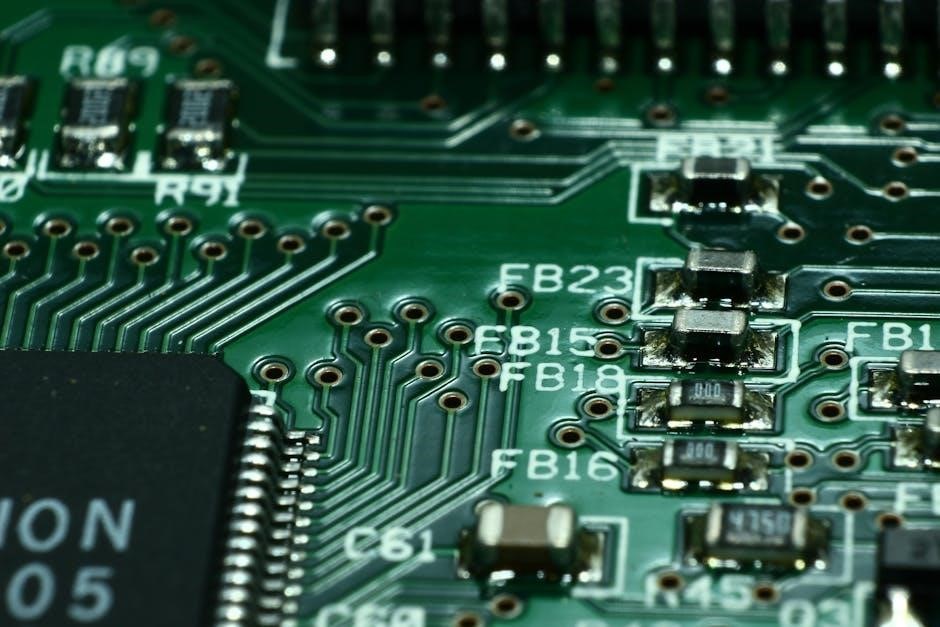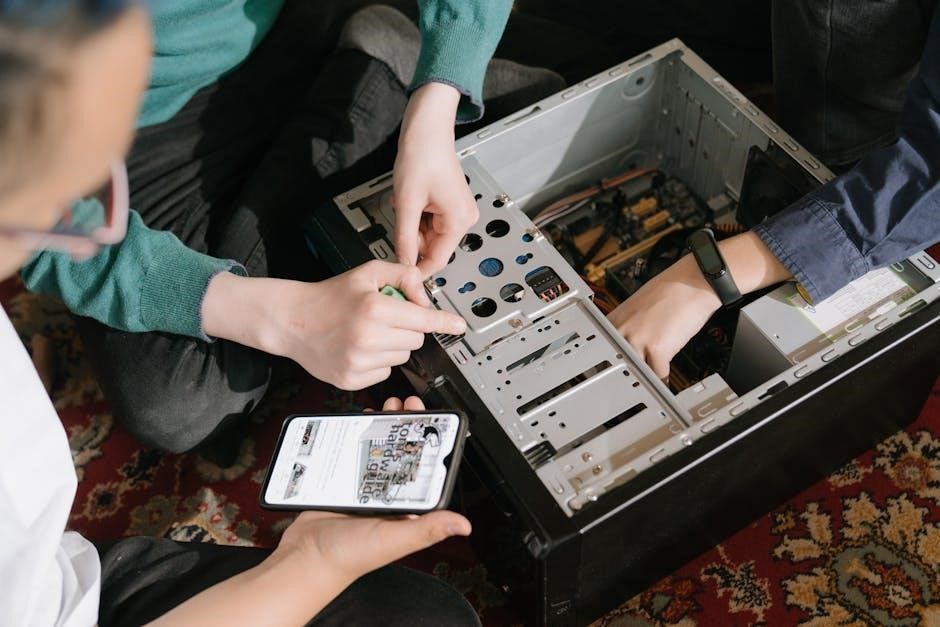
Regenerative radio circuits, like the 1e7g, use feedback to amplify weak signals, enhancing sensitivity and selectivity. They are energy-efficient and historically significant in radio technology development.
1.1 Definition and Purpose
A regenerative radio circuit, such as the 1e7g, is an electronic circuit that uses feedback to amplify weak radio signals, improving sensitivity and selectivity. Its primary purpose is to detect and strengthen incoming signals while maintaining fidelity. This design is particularly effective in low-power applications, offering a balance between simplicity and performance. The circuit’s ability to regenerate signals through controlled feedback makes it highly efficient for tuning and filtering, ensuring clear reception even in challenging conditions. Its compact design and energy efficiency further enhance its practicality in various radio systems.
1.2 Historical Background
Regenerative radio circuits, including the 1e7g, trace their origins to early 20th-century radio technology. Developed as a method to amplify weak signals, these circuits gained prominence due to their simplicity and efficiency. Pioneers like Edwin Armstrong contributed significantly to their evolution, showcasing their potential in improving radio reception. Historically, regenerative circuits were vital for early broadcasters and enthusiasts, offering a cost-effective solution for tuning and signal detection. Their legacy endures in modern applications, blending classic design principles with contemporary innovations to remain relevant in amateur and experimental radio systems.
1.3 Importance in Radio Technology
Regenerative radio circuits, such as the 1e7g, hold significant importance in radio technology for their ability to enhance signal reception with minimal components. They provide high sensitivity and selectivity, making them ideal for weak signal detection. Their energy efficiency and simplicity contribute to cost-effectiveness and reliability, especially in low-power applications. These circuits are fundamental in amateur radio and educational settings, offering hands-on learning opportunities for understanding feedback mechanisms and tuning principles. Their continued relevance underscores their value in both historical and modern radio systems, ensuring their place in the evolution of communication technology.

Understanding the 1e7g Regenerative Radio Circuit
The 1e7g circuit is a classic regenerative design, known for its simplicity and efficiency. It uses feedback to amplify signals, offering excellent sensitivity and selectivity for amateur use.
2.1 Overview of the Circuit Design
The 1e7g regenerative radio circuit is a straightforward yet efficient design, leveraging feedback to enhance signal amplification. It features a minimalist architecture with a focus on simplicity and performance. The circuit incorporates a feedback loop to regenerate weak signals, improving sensitivity and selectivity. This design is particularly favored in amateur radio projects due to its ease of construction and robust functionality; The 1e7g circuit is well-documented, making it accessible for hobbyists and educational purposes. Its compact layout and minimal component count contribute to its popularity among radio enthusiasts.
2.2 Key Components and Their Functions
The 1e7g circuit relies on a few critical components, each serving a distinct role. The vacuum tube or transistor acts as the active device, providing amplification and detection of signals. Passive components such as resistors, capacitors, and inductors fine-tune the circuit’s frequency response and feedback loop. The antenna captures incoming signals, while the tuning coil adjusts resonance for optimal signal reception. Together, these elements work in harmony to achieve high sensitivity and selectivity, making the 1e7g design both effective and reliable for amateur radio applications.
2.3 Circuit Diagram and Schematic
The circuit diagram and schematic of the 1e7g regenerative radio circuit illustrate the interconnected components, including the antenna, tuning coil, active devices, and passive elements. These visual representations are crucial for understanding the circuit’s layout and assembly. Standard electronic symbols are used to denote components like resistors, capacitors, and inductors. The diagram highlights the feedback loop, essential for signal regeneration, allowing precise control over sensitivity and selectivity. This clear and organized layout aids in both construction and troubleshooting, making it invaluable for hobbyists and engineers alike.
Working Principle of Regenerative Circuits
Regenerative circuits operate by feeding a portion of the output signal back into the input, enhancing sensitivity and selectivity through controlled feedback amplification.
3.1 The Role of Feedback in Regeneration
Feedback is integral to regenerative circuits, enabling signal amplification by reintroducing a portion of the output back into the input. This controlled feedback loop enhances sensitivity and selectivity, allowing weak signals to be detected more effectively. The feedback circuitry is carefully tuned to avoid oscillation, ensuring stable operation. In the 1e7g circuit, feedback is crucial for maintaining the balance between amplification and noise reduction, making it a cornerstone of the circuit’s functionality and performance.
3.2 Signal Amplification and Detection
Regenerative circuits excel in amplifying weak signals through a feedback loop, enhancing sensitivity. The 1e7g circuit detects signals by converting them into audible form, leveraging the feedback to boost amplitude. This process ensures clear reception even with minimal input, making it ideal for low-power applications. The circuit’s ability to amplify and detect signals efficiently is a key feature, balancing sensitivity with stability to deliver reliable performance in various radio frequency scenarios.
3.3 Tuning and Selectivity in the Circuit
Tuning in the 1e7g circuit involves adjusting components like capacitors and coils to resonate at the desired frequency, ensuring precise signal capture. Selectivity is enhanced by the circuit’s feedback mechanism, which helps filter out adjacent frequencies, improving clarity. The regenerative design allows for fine adjustments, balancing sensitivity and selectivity to optimize performance. Proper tuning ensures stable operation, preventing oscillation while maintaining sharp bandwidth control. This feature is crucial for clear signal reception in crowded radio spectra, making the circuit versatile for various applications.

Components of the 1e7g Circuit
The 1e7g circuit comprises essential components such as transistors, resistors, capacitors, inductors, and the antenna system. Each part plays a vital role in signal reception and amplification, ensuring optimal performance and selectivity.
4.1 Active Devices (Vacuum Tubes/Transistors)
Active devices in the 1e7g circuit, such as vacuum tubes or transistors, are crucial for amplifying and detecting radio signals. Vacuum tubes historically provided high sensitivity and selectivity, while modern designs often use transistors for their efficiency and reliability. These components act as amplifiers, boosting weak signals to a detectable level. Transistors, in particular, offer compact size and lower power consumption, making them ideal for contemporary implementations. Proper selection and configuration of these active devices ensure optimal performance, enabling the circuit to function effectively across its intended frequency range with minimal distortion.
4.2 Passive Components (Resistors, Capacitors, Inductors)
Passive components in the 1e7g circuit, such as resistors, capacitors, and inductors, play a vital role in signal processing and tuning. Resistors set voltage and current levels, ensuring stable operation. Capacitors are used for filtering and tuning, while inductors enable impedance matching and frequency selection. These components work together to optimize signal flow, ensuring precise tuning and selectivity. Proper selection of passive elements is essential to achieve the desired frequency response and sensitivity in the regenerative radio circuit, making them fundamental to its overall performance and functionality.
4.3 The Role of the Antenna and Tuning Coil
The antenna in the 1e7g circuit captures incoming radio signals, converting them into electrical currents. The tuning coil, paired with capacitors, forms a resonant circuit, allowing precise frequency selection. This combination ensures that only desired signals are amplified, enhancing selectivity. The antenna’s efficiency and the tuning coil’s quality directly impact the circuit’s sensitivity and performance. Together, they are crucial for effective signal reception and tuning in regenerative radio circuits, making them indispensable components for achieving optimal radio communication and signal clarity.
Design Considerations and Optimization
Optimizing the 1e7g circuit involves selecting components for low noise and high stability, ensuring proper PCB layout to minimize interference, and optimizing power supply for reliable operation.
5.1 Component Selection for Optimal Performance
Selecting high-quality components is crucial for the 1e7g circuit’s performance. Use low-noise transistors or vacuum tubes for consistent amplification. Choose capacitors with minimal leakage and inductors with high Q-factor for stable tuning. Resistors should have tight tolerance to maintain circuit balance. Ensure all components are rated for the expected voltage and current. Proper material selection, such as using air-core inductors, minimizes parasitic effects. Precision tuning capacitors and adjustable resistors allow for fine calibration. This careful selection ensures optimal sensitivity, stability, and fidelity in signal reception.
5.2 PCB Layout and Circuit Geometry
A well-designed PCB layout is essential for optimal performance in the 1e7g regenerative radio circuit. Proper component placement minimizes noise and ensures stable signal flow. Keep high-frequency signal paths short to reduce electromagnetic interference. Use a ground plane to shield sensitive components and maintain signal integrity. Ensure adequate spacing between traces to prevent cross-talk. The geometry of inductors and capacitors should be optimized for minimal parasitic effects. A compact, symmetrical layout enhances tuning accuracy and reduces unwanted resonances, ensuring reliable operation across the desired frequency range.
5.3 Power Supply and Voltage Requirements
The 1e7g regenerative radio circuit typically operates on a 9V DC power supply, ensuring stable performance and minimal power consumption. Voltage requirements are critical to maintain proper signal amplification and detection. A regulated power supply is recommended to avoid fluctuations that could degrade sensitivity. The circuit is designed to be energy-efficient, drawing minimal current while maintaining high sensitivity. Proper power conditioning and filtering are essential to prevent noise and interference. Using a stable voltage source ensures reliable operation and optimal signal quality across the tuning range.
Performance Characteristics
The 1e7g regenerative radio circuit excels in sensitivity, selectivity, and fidelity, ensuring clear signal reception. Its design minimizes distortion, providing high-quality audio output and stable performance across frequencies.
6.1 Sensitivity and Signal-to-Noise Ratio
The 1e7g regenerative radio circuit demonstrates high sensitivity, effectively detecting weak signals due to its feedback mechanism. The signal-to-noise ratio is optimized through selective filtering, ensuring clear audio output. This design enhances the circuit’s ability to distinguish desired signals from background noise, improving overall reception quality. The sensitivity is further boosted by the circuit’s low noise floor, making it suitable for both strong and weak signal environments. This balance between sensitivity and noise reduction ensures reliable performance across various operating conditions.
6;2 Selectivity and Bandwidth Control
The 1e7g regenerative radio circuit offers excellent selectivity, achieved through precise tuning of its feedback loop and resonant circuit. Bandwidth control is managed by adjusting the regeneration level and tuning coil capacitance, allowing users to narrow or broaden the frequency response. This feature ensures sharp filtering of unwanted signals, improving the circuit’s ability to isolate desired frequencies. The variable selectivity makes the circuit adaptable for different operating conditions, balancing between capturing weak signals and rejecting interference effectively.
6.3 Distortion and Fidelity in Reception
The 1e7g regenerative radio circuit is designed to minimize distortion and maximize fidelity in signal reception. By carefully controlling the feedback loop and selecting high-quality components, such as precision resistors and capacitors, the circuit ensures that the amplified signal remains faithful to the original transmission. Proper tuning of the resonant circuit, including the antenna and tuning coil, further enhances fidelity by optimizing frequency response and reducing unwanted noise and artifacts. This balance between distortion reduction and accurate signal reproduction makes the 1e7g circuit highly effective in maintaining clear and reliable radio communication.
Applications of Regenerative Radio Circuits
Regenerative radio circuits, like the 1e7g, are popular in amateur radio for their simplicity and efficiency; They are also used in educational settings for teaching radio fundamentals and in niche applications where low-power, high-sensitivity reception is required.
7.1 Amateur Radio and Hobbyist Projects
Regenerative radio circuits, such as the 1e7g, are highly popular among amateur radio enthusiasts and hobbyists due to their simplicity and efficiency. These circuits are often used in DIY projects, offering a cost-effective and educational way to build and operate radio receivers. Hobbyists appreciate the hands-on experience of assembling and tuning regenerative circuits, which provides a deeper understanding of radio fundamentals. Additionally, the compact design and low power consumption make them ideal for portable and experimental setups, fostering creativity and innovation within the amateur radio community.
7.2 Educational and Experimental Use
Regenerative radio circuits, such as the 1e7g, are invaluable in educational settings for teaching radio fundamentals. They provide a hands-on approach for understanding feedback mechanisms and signal amplification. In experimental contexts, these circuits allow researchers to explore new radio communication methods and test innovative ideas. Their simplicity makes them ideal for classroom demonstrations and advanced research, fostering innovation and deeper understanding of radio technology principles. They also help students develop essential engineering skills like troubleshooting and circuit optimization.
7.3 Niche Applications in Modern Radio Systems
Regenerative radio circuits, such as the 1e7g, find niche applications in modern radio systems where simplicity and low power consumption are advantageous. They are used in emergency communication devices due to their reliability and minimal energy requirements. Additionally, they are integrated into low-power wireless devices, such as IoT sensors, for efficient signal transmission. These circuits also serve in amateur radio setups for experimental purposes and in educational projects to demonstrate fundamental radio principles. Their versatility ensures relevance in specialized modern applications, despite advancements in technology.

Advantages and Limitations
Regenerative circuits offer high sensitivity and power efficiency but require precise feedback control, limiting stability and bandwidth in complex environments.
8.1 Benefits of Regenerative Design
Regenerative circuits, like the 1e7g, offer enhanced sensitivity and selectivity, enabling weak signal detection with minimal components. They consume less power, making them energy-efficient and ideal for portable devices. The feedback mechanism improves signal amplification without additional stages, reducing circuit complexity. This design is cost-effective, lightweight, and suitable for hobbyists and educational projects. Its simplicity also makes it adaptable for various frequency ranges, ensuring versatility in amateur radio applications. These advantages make regenerative designs appealing for those seeking a balance between performance and simplicity in radio technology.
8.2 Limitations and Challenges
Regenerative circuits, such as the 1e7g, face challenges like instability and potential oscillation due to feedback. They may struggle with poor selectivity, requiring precise tuning. Weak signal handling can lead to distortion, and component tolerances significantly impact performance. Additionally, the circuit’s sensitivity to tuning adjustments can make operation less user-friendly. These limitations make regenerative designs less suitable for high-fidelity applications and modern systems requiring stable, precise operation. Despite their advantages, these challenges necessitate careful design and adjustment to optimize functionality.
8.3 Comparison with Other Radio Circuits
Regenerative circuits differ from superheterodyne and direct-conversion designs in their use of feedback for amplification. While they excel in simplicity and low power consumption, they often lack the stability and selectivity of modern circuits. Superheterodyne receivers offer better performance but are more complex, whereas direct-conversion circuits provide excellent integration capabilities. Regenerative designs, like the 1e7g, are favored for their vintage appeal and educational value but are less practical for high-fidelity or commercial applications due to their inherent limitations in signal handling and stability.

Construction and Assembly Guide
Building the 1e7g circuit requires gathering components like vacuum tubes, resistors, and capacitors. Use proper tools for soldering and assembly, following a step-by-step guide for accuracy and safety.
9.1 Tools and Materials Required
Constructing the 1e7g regenerative radio circuit requires specific tools and materials. Essential tools include a soldering iron, wire strippers, pliers, screwdrivers, and a multimeter for testing. Materials needed are resistors, capacitors, inductors, diodes, transistors, and high-quality wire. A breadboard or PCB is recommended for assembly. Additional items like a tuning coil, antenna, and power supply are necessary for functionality. Ensure all components are of the correct specifications to maintain circuit performance and reliability. Proper safety gear, such as gloves and goggles, should be used during assembly.
9.2 Step-by-Step Assembly Instructions
9.3 Tips for Troubleshooting Common Issues
Start by checking all connections for soldering errors or loose wires. Ensure proper polarization of capacitors and diodes to prevent circuit damage. If the circuit fails to oscillate, adjust the regeneration control or verify feedback loop integrity. For poor signal reception, inspect the antenna and tuning coil alignment. Check power supply voltage and ensure it matches the circuit requirements. Use an oscilloscope to detect unwanted oscillations or signal distortions. Finally, test each component individually to isolate and resolve faults efficiently.

Testing and Calibration
Begin with initial power-up and safety checks to ensure proper circuit operation. Proceed with tuning adjustments and alignment procedures to optimize performance and verify signal accuracy effectively.
10.1 Initial Power-Up and Safety Checks
Before powering up the 1e7g circuit, ensure all components are securely connected and voltage levels match specifications; Turn on the power supply gradually, monitoring for unusual heat or smells. Verify that all capacitors are discharged and test the circuit’s ground connection to prevent electrical shocks. Use a multimeter to check voltage at critical points, ensuring no shorts or open circuits exist. Proper safety measures protect both the circuit and the user during initial testing phases.
10.2 Tuning and Alignment Procedures
Tuning the 1e7g circuit involves adjusting the regeneration control and tuning coil for optimal signal reception. Start by setting the feedback to a low level, then gradually increase it while monitoring the signal strength. Use a signal generator to align the circuit with the desired frequency range. Ensure the tuning capacitor and coil are properly aligned for resonance. Fine-tune the circuit by adjusting component values as needed to achieve the best performance. This step requires patience and careful monitoring to avoid over-regeneration or signal distortion.
10.3 Performance Measurement and Verification
Performance measurement involves evaluating the 1e7g circuit’s sensitivity, selectivity, and signal-to-noise ratio. Use test signals to verify the circuit’s ability to detect weak signals and maintain clarity. Measure voltage levels at critical points to ensure proper operation. Verify resonance by checking the tuning coil’s alignment with the desired frequency range. Use an oscilloscope or signal analyzer to monitor waveform integrity. Ensure distortion levels are minimal and the circuit operates within the expected bandwidth. This step confirms the circuit’s reliability and optimal performance across various operating conditions.
Modern Relevance and Modifications
Modern updates to the 1e7g circuit include digital integration and miniaturization, enhancing performance and energy efficiency while maintaining its core regenerative principles for improved functionality in contemporary applications.
11.1 Updates and Improvements in Design
Modern designs of the 1e7g regenerative radio circuit incorporate advanced components and digital integration, improving signal processing and efficiency. Miniaturization techniques reduce size while maintaining performance. Enhanced feedback mechanisms and improved tuning coils boost selectivity and sensitivity. Modern materials, such as high-quality capacitors and inductors, reduce signal loss and noise. Additionally, software-defined radio (SDR) integration allows for real-time adjustments and digital filtering. These updates ensure the circuit remains relevant, offering better fidelity and versatility for contemporary applications while preserving its foundational regenerative principles.
11.2 Integration with Modern Radio Systems
The 1e7g regenerative radio circuit can be seamlessly integrated with modern radio systems, enhancing their functionality. By incorporating software-defined radio (SDR) technology, the circuit allows for digital signal processing and real-time adjustments. Modern systems benefit from its high sensitivity and selectivity, making it suitable for hybrid analog-digital setups. Additionally, the circuit can be paired with advanced digital filters and IoT-enabled devices for remote control and monitoring. This integration ensures compatibility with contemporary communication standards while maintaining the circuit’s unique regenerative capabilities, offering a blend of traditional and cutting-edge radio technology.
11.3 Future Prospects for Regenerative Circuits
Regenerative radio circuits, such as the 1e7g, hold promise for future applications in low-power and niche radio systems. Their simplicity and energy efficiency make them suitable for integration with sustainable energy sources and IoT devices. Advances in semiconductor technology could further enhance their performance and adaptability. While modern circuits dominate, regenerative designs may find renewed relevance in specialized areas like amateur radio and educational projects. However, their adoption in mainstream systems remains limited due to the complexity of modern communication standards and the need for advanced signal processing capabilities.

Resources and Further Reading
Explore detailed guides, manuals, and tutorials on regenerative circuits, including Regenerative Radio Circuits: A Comprehensive Guide and online forums like AmateurRadioForum.com for hands-on insights.
12.1 Recommended Literature and Manuals
For in-depth understanding, refer to Regenerative Radio Circuits: Theory and Design and Amateur Radio Engineering. Online resources like ARRL Handbook and Radio Circuit Design provide detailed insights. Manufacturer datasheets and application notes, such as those from NXP or Texas Instruments, offer practical guidance. Additionally, Practical Radio Circuit Design by Douglas Self is highly recommended for hands-on builders. These resources cover theory, design, and implementation, making them invaluable for both beginners and experienced engineers.
12.2 Online Communities and Forums
Engage with online forums like Reddit’s r/amateurradio and r/electronics, which offer valuable discussions and resources for regenerative radio circuits. Stack Exchange’s Electrical Engineering community provides technical insights and troubleshooting tips. Facebook groups dedicated to vintage radio restoration and DIY electronics are also excellent for connecting with enthusiasts. These platforms foster collaboration, knowledge sharing, and problem-solving, making them indispensable for both hobbyists and professionals working with the 1e7g circuit.
12.3 Video Tutorials and Practical Guides
YouTube channels like ElectroBOOM and Applied Science offer hands-on tutorials for building and optimizing regenerative radios. Websites such as Instructables provide step-by-step guides with schematics and photos. For the 1e7g circuit, search for videos demonstrating DIY assembly and tuning techniques. Platforms like Vimeo also host detailed workshops on vintage radio restoration. These resources are ideal for hobbyists and educators seeking practical, visual instruction to complement theoretical knowledge and enhance their projects.